If you caught the article that I wrote in Railfan & Railroad Magazine for Grand Central Terminal’s centennial, you’re likely familiar with my thought that GCT is not just a beautiful building, but one that is still relevant and useful. Undoubtedly there are people out there that feel that Grand Central is just a washed up relic – a shadow of its former self. The mighty trains that once served the station – like the Empire State Express, and the Twentieth Century Limited – are long gone. In fact, since Amtrak left in 1991, not a single long distance train serves Grand Central – it is a commuter-only station. But just because the main demographic the station serves has changed, it doesn’t make Grand Central any less of a gem. Grand Central remains useful and relevant partly because it has reinvented itself over the years – all to keep pace with that changing demographic. The baggage check and a theater once located here seem suited for the long-distance traveler of yesteryear, while Grand Central Market is perfectly tailored to today’s busy commuter.
Although never the most glamorous, commuters have always been an important part of Grand Central’s history. The lower level of the Terminal, which now houses the “dining concourse,” was the realm of the commuter – the “suburban concourse.” Part of the wonderful design of Grand Central was that commuters never had to mingle with the long distance riders. They had easy access to the ramps, subway, and egress to get to where they needed to go. But that wasn’t the only difference between the two types of riders – commuters were also differentiated by the type of ticket they held. Monthly commuter tickets looked quite different from regular ride tickets, and over the past one hundred years their design changed many times. Here’s a look back at some of the varied styles, and one of the favorites in my collection.
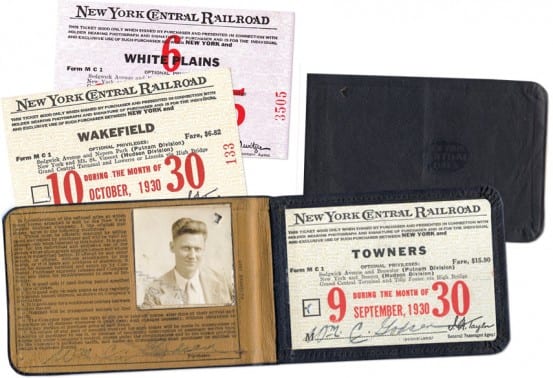
This ticket booklet, stamped with the New York Central logo contained a photo of the rider, so no one else could use it. The monthly ticket could slip inside the pouch and was visible to the conductor.
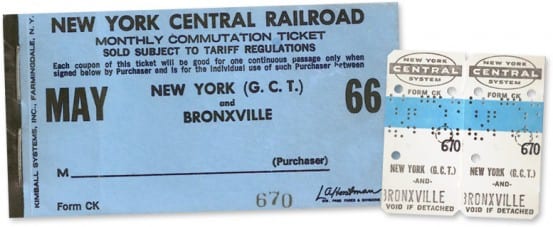
A coupon book style ticket. Little ticket coupons inside were ripped out by the conductor for each ride.
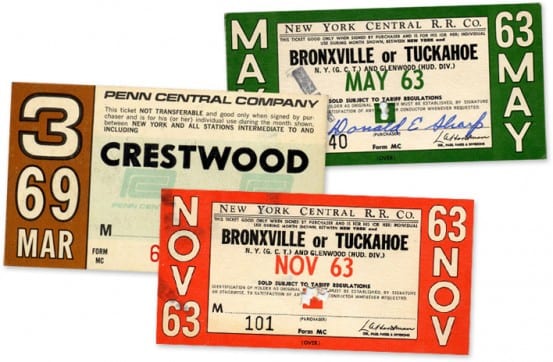
Various tickets with colored backgrounds. Similar to today’s monthly, the color changed each month, so it was easily visible to the conductor.
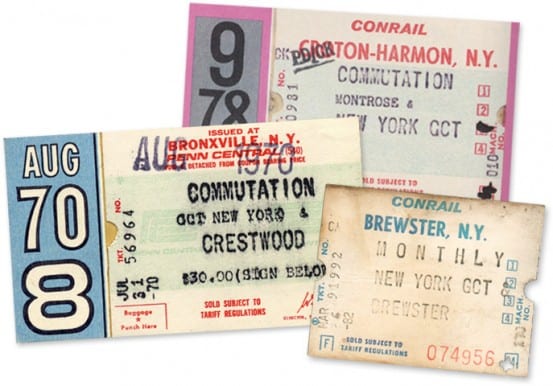
Similar to the colored tickets above, these tickets contained a printed and pasted on portion which listed the station information.
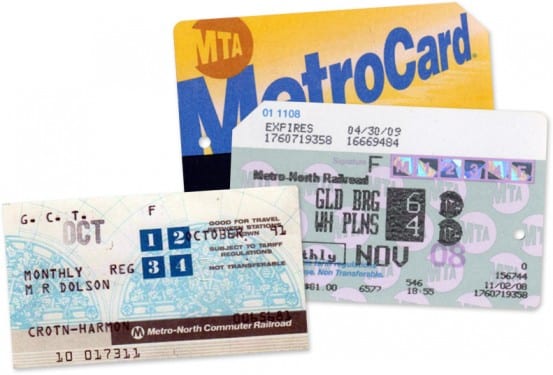
More modern Metro-North tickets. Today’s ticket can double as a Metro-Card.
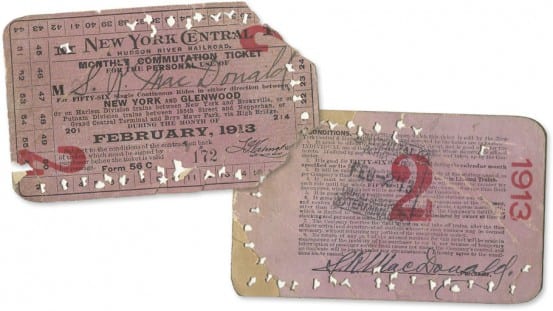
My favorite monthly ticket – note the date that it was purchased. February 2nd, 1913 was the day Grand Central Terminal opened to the public. This type of ticket had boxes surrounding it, which the conductor clipped with each ride.


ahhhh I love this so much! You do such an amazing job, Emily! (and side note: I have every Metro North monthly pass I’ve ever purchased, since September 2007! I can’t bear to part with them)
Thanks! I have all of mine saved too! The one that I scanned for the post is my first monthly that I purchased… I had been taking the train a little bit longer, but since I started as a temp I had only been buying weeklys.
You should scan some of your earliest tickets so I can put them up on the site :)
Great stuff, especially the 2/2/13 gem. Better keep that in a safe place; the acid paper is going fast.
Believe it or not, that just came in the mail two nights ago. When I purchased it I didn’t even notice the date… when I pulled it out of the envelope I was like “holy crap!”
1) When my mom worked in the Flatiron district in the ’90s for a publishing firm, she would commute from Brewster North (I still can’t come to call it Southeast), and going through some of her old things I found most of her old monthly tickets. She’s let me keep the old monthly tickets because she knows that I’ll take decent care of them.
2) And to say that GCT is strictly a commuter rail station is mostly correct, but if you felt like it you could say (unofficially) that the New Haven Line service to New Haven, Danbury and Waterbury is intercity, (potential through) future New Haven Line service to New London and Hartford might also end up on that list. And you can’t forget service to Poughkeepsie.
I still think that Amtrak could serve GCT with service to Albany without cannibalizing customers from Penn Station. In fact, according to a senior Amtrak official who I met on a southbound Empire Service train in December of 2010, there has been talk for a while in regards to Amtrak serving GCT with a small handful of trains, but Metro-North always complains about how “congested” GCT is, among other things. Amtrak’s P32AC-DM’s (if I recall correctly) were originally going to have a tensioned third rail shoe that could be adjusted for service to both Penn Station and GCT, but it never really came to fruition. But Amtrak, as far as I can tell, has not forgotten GCT (the detours back in 2008 and last year’s National Train Day are examples).
But keep in mind once the East Side Access project, Second Avenue Subway and the IRT Flushing line is extended to the West Side, the dynamics of rail operations into NYC will change forever. LIRR has only 5 dedicated tracks at Penn. At GCT, it will be eight, and those will be strictly for the LIRR only.
I know what you mean about Brewster North ;)
You should scan some of your mother’s old tickets for me!
You are right about the wording on the commuter thing. I should say something more along the lines of local trains. Metro-north does have quite a ridership among non commuters, but everyone is local. No more rides to Chicago :(
Come to think of it, another, albeit not all that likely reason Amtrak is not easily able to come back to GCT is due to a lack of cab cars. At the last hurrah of Amtrak’s GCT operations in the late ’80s, Amtrak scheduled many of its routes with the Rohr Turboliners and the rebuilt RTGs. The turboliners had control cabs at both ends, thus Amtrak didn’t need to use the loop below GCT to turn trains around. The playing field is different today as well. Vermont makes use of one of the NYP-ALB Empire Service frequencies for the Ethan Allen Express, which despite being funded by the Vermont Agency of Transportation, makes more stops in New York than Vermont.
And I’ll scan those monthly tickets. I found the design for the early 1995 tickets used the old MTA logo and not the one introduced in 1994.
My grandmother, who rode the Putnam Division to and from Mount Hope, had one of those picture tickets. She replaced her picture (She didn’t like it) with one of Mae West. Nothing was ever said. When she passed it was in her effects and was “dumped”. Sure wish it was saved.
Aww, darn! I would have loved to see that!
In the 1960s and 1970s the Penn Central/Conrail utilized a Burroughs “Ticketeer” printing machine at large stations (see above tickets from 1970 and 1978). The ticket agent pulled a long slat from a rack and inserted into a machine. The station information and fare was contained on the slat and imprinted on the ticket, kind of like an Addressograph impression. Presumably cost and accounting information was also on the slat and printed on a control tape within the machine. There were separate slats for each fare zone and ticket type. Sometimes the printed ticket included a receipt or return tickets for a round trip fare.
Certain monthly tickets had a blank with the month and year, and a sticky surface on which the imprinted ticket was placed. The August 1970 example above may have been that type.
Some bus companies at Port Authority may have used it as well.
Hi, maybe you have the answer to this question. I ride Metro North and I have a monthly pass- this month- it is aqua colored. Recently I was on the train and twice I saw someone present what looked like a monthly card..but it was not aqua- it was orange colored. Do you know what the difference is?
Lily, someone in the Mail & Ride department screwed up this month and sent out tickets of the wrong color. If you bought your monthly from a machine or ticket window, it is of a different color than the one sent in the mail to mail and ride subscribers. Both tickets are, however, valid for this month.